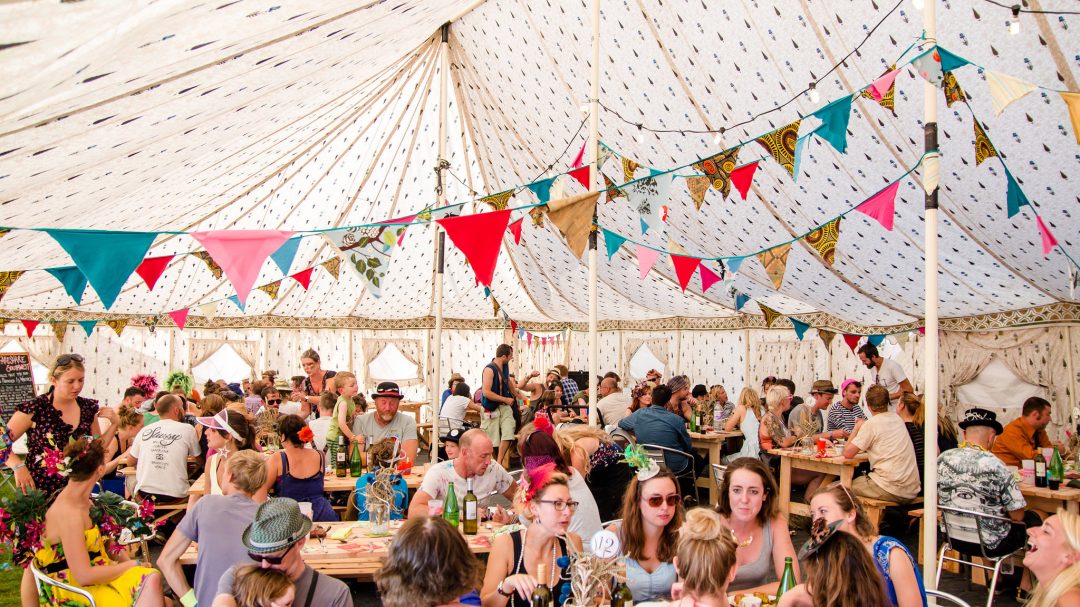

Green house gases (GHG) including carbon and methane are generated throughout the lifecycle of food from growth, production, transportation, packaging, processing and distribution.
Food is a core part of most events and the quality and provenance can reflect on the event. Although the carbon footprint of food is harder to quantify than energy and audience travel, there are choices that can be made to limit the impact of menus, traders and caterers, whilst improving the quality, flavour and also saving money.
1. REDUCE FOOD MILES
- Choose local in-season ingredients for menus or provide traders and onsite caterers with a local supplier list, seeking out small-scale producers and farmers.
- Where possible choose local traders and caterers, or have a quota who are locals. (This is also great for improving your event’s reputation within the area by bolstering the local economy).
2. CHOOSE FAIRTRADE
- For all the items that don’t grow locally (tea, coffee, sugar, chocolate) the Fairtrade certification includes environmental standards to reduced CO2 and pesticide impacts, as well as supporting small scale farmers. See this inspiring video
3. REDUCE THE QUANTITY OF MEAT, DAIRY & PROCESSED FOODS
A recent Chatham House report estimates 14.5% of the global green house gas emissions can be attributed to livestock which is more than the transport sector.
When we recognise that all factory production requires energy, heat and raw materials it makes sense that the more processed a food is the higher it’s carbon footprint is. For example frozen peas have a higher carbon footprint to fresh peas.
A UK study (EPIC-Oxford cohort study) of diets found that green house gas emissions were two times lower in plant-based dairy-free vegan diets than meat diets.
Reduce the quantity served
- Place meat at the end of a buffet after all the salads and carbohydrates.
- Serve a mezze-style menu rather than a traditional meat and two veg option.
Choose lower impact options
Compare the carbon impact of some common food items in these charts:
- Wrap Resource Map – Click on the Grocery sector Map for information on 50 grocery items.
- Friends of the Earth – Page 12 has a carbon footprint chart. Page 20 has advise for festival organisers.
Get some inspiration for recipes and changing menus:
- Vegan Society Resources
- Sustainable Food in Urban Communities – Pages 31 to 36 detail changes to menus made by school caterers in developing low carbon menus in Sweden without increasing costs
4. REDUCE FOOD WASTE
Wasted food creates methane (at least 20 times greater global warming impact than CO2) if it ends up in landfill; to say nothing of all the carbon created in the growing, production and transportation of the raw materials.
- Give caterers and traders realistic figures, so they don’t over cater.
- Reduce plate and serving spoon sizes to avoid excessive portions
5. DISPOSAL
The aim is to avoid food ending up in landfill.
Salvaging Good Food
- For festivals, there are organisations such as Eighth Plate who collect food and cook it up.
- For daytime events, it is important that food has not been served or put out in order for a local charity to collect it.
Responsible Disposal
- Arrange for a collection to go to a compost or anarobic digestion facility. The Food Waste Network and Gather can both link you up with local collection agencies that are relevant to your event.
More Support
If you would like to know more about monitoring your carbon footprint, managing traders and greening your events; then look at our consultancy packages or drop us an email and we can develop a bespoke support package.


